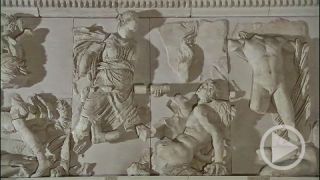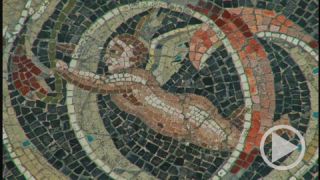
The collection’s main attraction gave the Pergamon Museum its name: the unique Pergamon Altar (2nd century BCE) with its fantastic frieze depicting the battle between the gods and Titans – a masterpiece of Hellenistic art. In addition, the museum contains the Market Gate of Miletus, an exquisite piece of Roman architecture, and other architectural remains.
Die Pracht von Pergamon
Pergamon war eine der mächtigsten griechischen Städte in Kleinasien. Die Könige der Attalid-Dynastie, die von 281 bis 133 v. Chr. regierten, verwandelten sie in eines der kulturellen Zentren der hellenistischen Welt...
Der Pergamon Altar
Der große Altar des Zeus ist ein unvergleichliches Meisterwerk hellenistischer Kunst. Erbaut von König Eumenes II. um 170 v. Chr., zeigt der Fries den "Kampf der Titanen": Die Götter des Olymp, angeführt von Zeus und Athene, kämpfen gegen die Söhne von Gaea, der Mutter der Erde.▶ The Museum of Islamic Art▶ Bergama

Hephaiston Mosaik
Ein prächtiges Mosaik aus dem größten Palast auf dem Burghügel von Pergamon, um 160 v. Chr. für Attalus II. geschaffen. Ein exquisiter Fries zeigt fast dreidimensionale Blumen, Tiere und Amoretten - ein kleines Paradies mit einer kuriosen Handschrift…▶ The Museum of Islamic Art▶ Bergama
Greek Statues - from Archaic to Classical and Beyond
In the 7th century BC the Greeks began sculpting life-size human figures in stone or bronze; this is considered the beginning of the “Archaic“ period. These depictions of humans, idealized yet naturalistic, set ancient Greek art apart from other cultures. From about 500 BC, during the “Classical“ era, statues increasingly depicted real rather than mythical people – and in the “Hellenistic“ period starting in the 4th century BC, sculptures became ever more life-like...

Berlin Goddess
This “Kore” is a magnificent example of ancient Greek art, created in about 570 B.C. It stands solemn and austere, yet with extremely finely done details, and shows the typical “ancient smile”. And we can still see that it was brightly painted…▶The Museum of Islamic Art▶ Keratea

Wounded Amazon
Pliny writes of how the best artists of the Greek classical era, between 450 and 420 B.C., were invited to sculpt an Amazon for the Ephesus Temple of Artemis. In a clever process the statue by Polyclitus was found to be the best. Is it this one?▶The Museum of Islamic Art▶ Ephesos

The Praying Boy
This wonderful bronze figure, cast in Rhodes in about 300 B.C. by a student of the great Lysippus, is a masterpiece with no less than 18 known owners. Does it depict young Apollo or Ganymede reaching for the eagle of Zeus – or simply a ball player?▶The Museum of Islamic Art▶ Rhodes

Caesar & Cleopatra
Two busts of the most famous lovers of all antiquity. The bust of Cleopatra was part of a Hellenist statue and probably painted red and covered in shining gold; the bust of Caesar was also made in Egypt and emphasizes his assertiveness…▶The Museum of Islamic Art▶ Alexandria
The Transition from Archaic to Classical
Around 530 BC, the red-figure technique of Greek vase painting was invented, allowing the depiction of fine internal detail rather than black-figure silhouettes. One of the great masters of the new style was the "Berlin Painter" who worked around 500 BC...
Amphora by the Berlin Painter
A magnificent amphora with perfect proportions featuring Hermes and a drunken silenus. The artist painted them in a revolutionary way, marking the transition from ancient to classical Greek art in about 500 B.C. – but we still don’t know who he was…▶ The Collection of Classical Antiquities, Berlin▶ Athens

Sosias Bowl
Even though this is one of the greatest vases from Athens, we don’t know who the “Sosias Painter” was. Working around 500 B.C., he shows Achilles bandaging the arm of Patroclus - painting for the first time in Greek art, the figures' eyes in profile.▶ The Collection of Classical Antiquities, Berlin▶ Athens
Rome, Heir to the Greek Culture
The Romans greatly admired Greek culture; Greek myths in particular were models for many Roman works of art. But Roman artists did add their own creativity - as can be witnessed in a magnificent relief depicting one of the most shocking tales of Greek mythology...Ancient Treasures
An astonishing number of archaelogical discoveries have happened by pure chance. So, when digging anywhere in a European city, or even on a field, it may pay to be attentive…
Scythian Gold
In 1882, a farmer in the village of Vettersfelde ploughed his fields – and dug up a fabulous gold treasure. It turned out to be an archaeological sensation: he had found a cache of 2500-year old Scythian treasures, showing amazing goldsmith's artistry.▶The Museum of Islamic Art▶ Witaszkowo

Hildesheim Silver
In 1868, soldiers stumbled upon an antique dinner service: some 70 pieces of pure silver, some of them plated with gold, made during the era of Emperor Augustus – among them the Athena Bowl, one of the most beautiful pieces of Roman silver anywhere.▶The Museum of Islamic Art▶ Hildesheim
Address
- The Pergamon Museum
- Bodestraße
- 10178 Berlin
Links
Opening Hours
- Monday-Sunday 10:00-18:00
- Wednesday until 20:00






